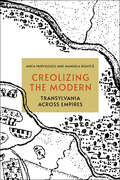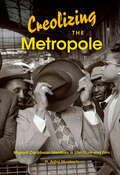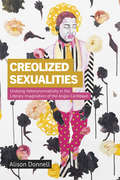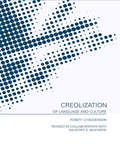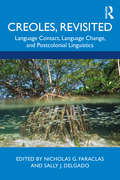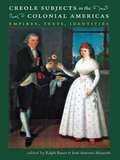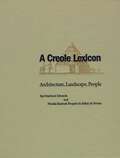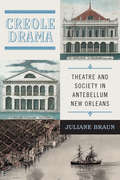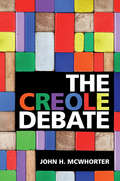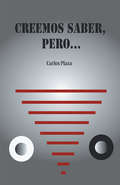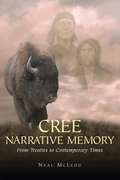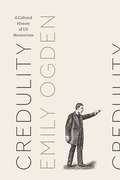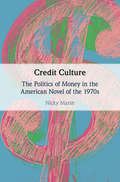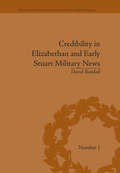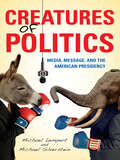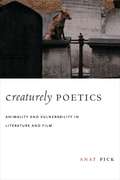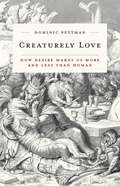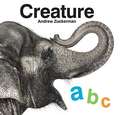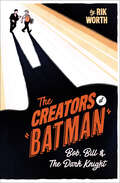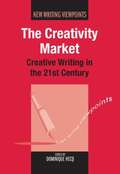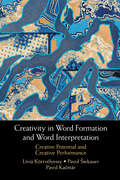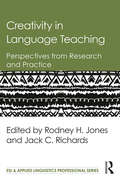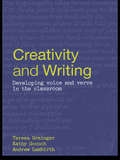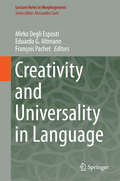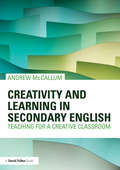- Table View
- List View
Creolizing the Modern: Transylvania across Empires
by Anca Parvulescu Manuela BoatcăHow are modernity, coloniality, and interimperiality entangled? Bridging the humanities and social sciences, Anca Parvulescu and Manuela Boatcă provide innovative decolonial perspectives that aim to creolize modernity and the modern world-system. Historical Transylvania, at the intersection of the Habsburg Empire, the Ottoman Empire, Austria-Hungary, and Russia, offers the platform for their multi-level reading of the main themes in Liviu Rebreanu's 1920 novel Ion. Topics range from the question of the region's capitalist integration to antisemitism and the enslavement of Roma to multilingualism, gender relations, and religion. Creolizing the Modern develops a comparative method for engaging with areas of the world that have inherited multiple, conflicting imperial and anti-imperial histories.
Creolizing the Metropole: Migrant Caribbean Identities In Literature And Film (Blacks In The Diaspora Ser.)
by H. Adlai MurdochCreolizing the Metropole is a comparative study of postwar West Indian migration to the former colonial capitals of Paris and London. It studies the effects of this population shift on national and cultural identity and traces the postcolonial Caribbean experience through analyses of the concepts of identity and diaspora. Through close readings of selected literary works and film, H. Adlai Murdoch explores the ways in which these immigrants and their descendants represented their metropolitan identities. Though British immigrants were colonial subjects and, later, residents of British Commonwealth nations, and the French arrivals from the overseas departments were citizens of France by law, both groups became subject to otherness and exclusion stemming from their ethnicities. Murdoch examines this phenomenon and the questions it raises about borders and boundaries, nationality and belonging.
Creolized Sexualities: Undoing Heteronormativity in the Literary Imagination of the Anglo-Caribbean (Critical Caribbean Studies)
by Alison DonnellCreolized Sexualities: Undoing Heteronormativity in the Literary Imagination of the Anglo-Caribbean draws attention to a wide, and surprising, range of writings that craft inclusive and pluralizing representations of sexual possibilities within the Caribbean imagination. Reading across an eclectic range of writings from V.S. Naipaul to Marlon James, Shani Mootoo to Junot Diaz, Andrew Salkey to Thomas Glave, Curdella Forbes to Colin Robinson, this bold work of literary criticism brings into view fictional worlds where Caribbeanness and queerness correspond and reconcile. Through inspired close readings Donnell gathers evidence and argument for the Caribbean as an exemplary creolized ecology of fluid possibilities that can illuminate the prospect of a non-heteronormalizing future. Indeed, Creolized Sexualities hows how writers have long rendered sexual plasticity, indeterminacy, and pluralism as an integral part of Caribbeanness and as one of the most compelling if unacknowledged ways of resisting the disciplining regimes of colonial and neocolonial power.
Creolization of Language and Culture
by Robert ChaudensonCreolization of Language and Culture is the first English edition of Robert Chaudenson's landmark text Des îles, des hommes, des langues, which has also been fully revised.. With reference to the main varieties of creole French, Chaudenson argues against the traditional account of creole genesis for a more sophisticated paradigm which takes full account of the peculiar linguistic and social factors at play in colonial societies.This is an accessible book which makes an important contribution to the study of pidgin and creole language varieties, as well as to the development of contemporary European languages outside Europe. Key features include:Analysis of current debates on the development of creolesDiscussion of many aspects of human culture including music, medicine, cooking, magic and folkloreTranslation of all French sources from which Chaudenson quotes extensively
Creoles, Revisited: Language Contact, Language Change, and Postcolonial Linguistics
by Nicholas G. Faraclas and Sally J. DelgadoThis innovative book contributes to a paradigm shift in the study of creole languages, forging new empirical frameworks for understanding language and culture in sociohistorical contact. The authors bring together archival sources to challenge dominant linguistic theory and practice and engage issues of power, positioning marginalized indigenous peoples as the center of, and vital agents in, these languages’ formation and development. Students in language contact, pidgins and creoles, Caribbean studies, and postcolonial studies courses—and scholars across many disciplines—will benefit from this book and be convinced of the importance of understanding creoles and creolization.
Creole Subjects in the Colonial Americas: Empires, Texts, Identities
by Ralph BauerCreolization describes the cultural adaptations that occur when a community moves to a new geographic setting. Exploring the consciousness of peoples defined as "creoles" who moved from the Old World to the New World, this collection of eighteen original essays investigates the creolization of literary forms and genres in the Americas between the sixteenth and nineteenth centuries. Creole Subjects in the Colonial Americasfacilitates a cross-disciplinary, intrahemispheric, and Atlantic comparison of early settlers' colonialism and creole elites' relation to both indigenous peoples and imperial regimes. Contributors explore literatures written in Spanish, Portuguese, and English to identify creole responses to such concepts as communal identity, local patriotism, nationalism, and literary expression. The essays take the reader from the first debates about cultural differences that underpinned European ideologies of conquest to the transposition of European literary tastes into New World cultural contexts, and from the natural science discourse concerning creolization to the literary manifestations of creole patriotism. The volume includes an addendum of etymological terms and critical bibliographic commentar. Contributors Ralph Bauer, University of Maryland Raquel Chang-Rodriguez, City University of New York Lucia Helena Costigan, Ohio State University Jim Egan, Brown University Sandra M. Gustafson, University of Notre Dame Carlos Jauregui, Vanderbilt University Yolanda Martinez-San Miguel, University of Pennsylvania Jose Antonio Mazzotti, Tufts University Stephanie Merrim, Brown University Susan Scott Parrish, University of Michigan Luis Fernando Restrepo, University of Arkansas, Fayetteville Jeffrey H. Richards, Old Dominion University Kathleen Ross, New York University David S. Shields, University of South Carolina Teresa A. Toulouse, Tulane University Lisa Voigt, University of Chicago Jerry M. Williams, West Chester University
A Creole Lexicon: Architecture, Landscape, People
by Jay Edwards Nicolas Kariouk VertonThroughout Louisiana's colonial and postcolonial periods, there evolved a highly specialized vocabulary for describing the region's buildings, people, and cultural landscapes. This creolized language -- a unique combination of localisms and words borrowed from French, Spanish, English, Indian, and Caribbean sources -- developed to suit the multiethnic needs of settlers, planters, explorers, builders, surveyors, and government officials. Today, this historic vernacular is often opaque to historians, architects, attorneys, geographers, scholars, and the general public who need to understand its meanings. With A Creole Lexicon, Jay Edwards and Nicolas Kariouk provide a highly organized resource for its recovery. Here are definitions for thousands of previously lost or misapplied terms, including watercraft and land vehicles, furniture, housetypes unique to Louisiana, people, and social categories. Drawn directly from travelers' accounts, historic maps, and legal documents, the volume's copious entries document what would actually have been heard and seen by the peoples of the Louisiana territory. Newly produced diagrams and drawings as well as reproductions of original eighteenth- and nineteenth-century documents and Historic American Buildings Surveys enhance understanding. Sixteen subject indexes list equivalent English words for easy access to appropriate Creole translations. A Creole Lexicon is an invaluable resource for exploring and preserving Louisiana's cultural heritage.
Creole Drama: Theatre and Society in Antebellum New Orleans (Writing the Early Americas)
by Juliane BraunThe stages of antebellum New Orleans did more than entertain. In the city’s early years, French-speaking residents used the theatre to assert their political, economic, and cultural sovereignty in the face of growing Anglo-American dominance. Beyond local stages, the francophone struggle for cultural survival connected people and places in the early United States, across the American hemisphere, and in the Atlantic world.Moving from France to the Caribbean to the American continent, Creole Drama follows the people that created and sustained French theatre culture in New Orleans from its inception in 1792 until the beginning of the Civil War. Juliane Braun draws on the neglected archive of francophone drama native to Louisiana, as well as a range of documents from both sides of the Atlantic, to explore the ways in which theatre and drama shaped debates about ethnic identity and transnational belonging in the city. Francophone identity united citizens of different social and racial backgrounds, and debates about political representation, slavery, and territorial expansion often played out on stage.Recognizing theatres as sites of cultural exchange that could cross oceans and borders, Creole Drama offers not only a detailed history of francophone theatre in New Orleans but also an account of the surprising ways in which multilingualism and early transnational networks helped create the American nation.
The Creole Debate
by John H. McWhorterCreoles have long been the subject of debate in linguistics, with many conflicting views, both on how they are formed, and what their political and linguistic status should be. Indeed, over the past twenty years, some creole specialists have argued that it has been wrong to think of creoles as anything but language blends in the same way that Yiddish is a blend of German and Hebrew and Slavic. <P><P>Here, John H. McWhorter debunks the most widely accepted idea that creoles are created in the same way as 'children', taking characteristics from both 'parent' languages, and its underlying assumption that all historical and biological processes are the same. Instead, the facts support the original, and more interesting, argument that creoles are their own unique entity and are among the world's only genuinely new languages.<P> Presents data from a wide range of creoles, not just the restricted few that are largely studied by uniformitarians.<P> Presents counter arguments to the uniformitarian view, which many linguists will have had little exposure to before.<P> Reveals creole studies to be far more widely ranging than often thought, including answering the oft-posed question as to what would happen if creoles were based on languages beyond Europe and Africa.
Creemos saber, pero...
by Carlos PlazaContinuamos narrando historias para el entretenimiento de uds., en este caso, en el libro que tienen en sus manos se narran las historias Triángulos amigos y la fenomenal No sabemos nada. Esta última está vista siempre desde el punto de vista del autor, que no tiene porqué coincidir con la tuya, amable lector. En la primera se narra un encuentro ocasional con unos amigos muy especiales, con unas noticias espectaculares y no menos especiales, aunque por algunos motivos no llegan a dárselas a nuestro protagonista. Respecto a a nuestra segunda historia he de decir que; todos sabemos lo que pasa cuando fallecemos: lloros, lamentos, ayes y demás... Además, nuestro cuerpo físico empieza a desintegrarse en su eterno reposo. Pero lo que no sabemos es lo que sucede con nuestra mente en esos momentos tan temidos por algunos. Esta narración trata de explicarlo, y claro, ustedes pensarán que se trata de una historia ficticia, pero, ¿y si no lo fuese?...
Cree Narrative Memory: From Treaties To Contemporary Times
by Neal McLeodNeal McLeod examines the history of the nêhiyawak (Cree People) of western Canada from the massive upheavals of the 1870s and the reserve period to the vibrant cultural and political rebirth of contemporary times. Central to the text are the narratives of McLeod's family, which give first hand examples of the tenacity and resiliency of the human spirit while providing a rubric for reinterpreting the history of Indigenous people, drawing on Cree worldviews and Cree narrative structures. <p><p> In a readable style augmented with extensive use of the Cree language throughout, McLeod draws heavily on original research, the methodology of which could serve as a template for those doing similar work. While the book is based on the Cree experience of the Canadian prairies, its message and methodology are applicable to all Indigenous societies.
Credulity: A Cultural History of US Mesmerism (Class 200: New Studies in Religion)
by Emily OgdenFrom the 1830s to the Civil War, Americans could be found putting each other into trances for fun and profit in parlors, on stage, and in medical consulting rooms. They were performing mesmerism. Surprisingly central to literature and culture of the period, mesmerism embraced a variety of phenomena, including mind control, spirit travel, and clairvoyance. Although it had been debunked by Benjamin Franklin in late eighteenth-century France, the practice nonetheless enjoyed a decades-long resurgence in the United States. Emily Ogden here offers the first comprehensive account of those boom years. Credulity tells the fascinating story of mesmerism’s spread from the plantations of the French Antilles to the textile factory cities of 1830s New England. As it proliferated along the Eastern seaboard, this occult movement attracted attention from Ralph Waldo Emerson’s circle and ignited the nineteenth-century equivalent of flame wars in the major newspapers. But mesmerism was not simply the last gasp of magic in modern times. Far from being magicians themselves, mesmerists claimed to provide the first rational means of manipulating the credulous human tendencies that had underwritten past superstitions. Now, rather than propping up the powers of oracles and false gods, these tendencies served modern ends such as labor supervision, education, and mediated communication. Neither an atavistic throwback nor a radical alternative, mesmerism was part and parcel of the modern. Credulity offers us a new way of understanding the place of enchantment in secularizing America.
Credit Culture: The Politics of Money in the American Novel of the 1970s
by Nicky MarshThis book offers a new reading of the relationship between money, culture and literature in America in the 1970s. The gold standard ended at the start of this decade, a moment which is routinely treated as a catalyst for the era of postmodern abstraction. This book provides an alternative narrative, one that traces the racialized and gendered histories of credit offered by the intertextual narratives of writers such as E.L Doctorow, Toni Morrison, Marilyn French, William Gaddis, Thomas Pynchon and Don De Lillo. It argues that money in the 1970s is better read through a narrative of political consolidation than formal rupture as these histories foreground the closing down, rather than opening up, of serious debates about what American money should be and who it should serve. These novels and this moment remain important because they alert us to imagine the alternative histories of credit that were imaginatively proposed but never realized.
Credibility in Elizabethan and Early Stuart Military News (Political and Popular Culture in the Early Modern Period #1)
by David RandallElizabethan and early Stuart England saw the prevailing medium for transmitting military news shift from public ritual, through private letters, to public newspapers. This study is based on an examination of hundreds of manuscript news letters, printed pamphlets and corantos, and news diaries which are in holdings in the US and the UK.
Creatures of Politics: Media, Message, And The American Presidency
by Michael Silverstein Michael LempertIt's a common complaint that a presidential candidate's style matters more than substance and that the issues have been eclipsed by mass-media-fueled obsession with a candidate's every slip, gaffe, and peccadillo. This book explores political communication in American presidential politics, focusing on what political insiders call "message." Message, Michael Lempert and Michael Silverstein argue, is not simply an individual's positions on the issues but the craft used to fashion the creature the public sees as the candidate. Lempert and Silverstein examine some of the revelatory moments in debates, political ads, interviews, speeches, and talk shows to explain how these political creations come to have a life of their own. From the pandering "Flip-Flopper" to the self-reliant "Maverick," the authors demonstrate how these figures are fashioned out of the verbal, gestural, sartorial, behavioral--as well as linguistic--matter that comprises political communication.
Creaturely Poetics: Animality and Vulnerability in Literature and Film
by Anat PickSimone Weil once wrote that "the vulnerability of precious things is beautiful because vulnerability is a mark of existence," establishing a relationship between vulnerability, beauty, and existence transcending the separation of species. Her conception of a radical ethics and aesthetics could be characterized as a new poetics of species, forcing a rethinking of the body's significance, both human and animal. Exploring the "logic of flesh" and the use of the body to mark species identity, Anat Pick reimagines a poetics that begins with the vulnerability of bodies, not the omnipotence of thought. Pick proposes a "creaturely" approach based on the shared embodiedness of humans and animals and a postsecular perspective on human-animal relations. She turns to literature, film, and other cultural texts, challenging the familiar inventory of the human: consciousness, language, morality, and dignity. Reintroducing Weil's elaboration of such themes as witnessing, commemoration, and collective memory, Pick identifies the animal within all humans, emphasizing the corporeal and its issues of power and freedom. In her poetics of the creaturely, powerlessness is the point at which aesthetic and ethical thinking must begin.
Creaturely Love: How Desire Makes Us More and Less Than Human
by Dominic PettmanTo our modern ears the word “creature” has wild, musky, even monstrous, connotations. And yet the terms “creaturely” and “love,” taken together, have traditionally been associated with theological debates around the enigmatic affection between God and His key creation, Man. In Creaturely Love, Dominic Pettman explores the ways in which desire makes us both more, and less, human. In an eminently approachable work of wide cultural reach and meticulous scholarship, Pettman undertakes an unprecedented examination of how animals shape the understanding and expression of love between people. Focusing on key figures in modern philosophy, art, and literature (Nietzsche, Salomé, Rilke, Balthus, Musil, Proust), premodern texts and fairy tales (Fourier, Fournival, Ovid), and contemporary films and online phenomena (Wendy and Lucy, Her, memes), Pettman demonstrates that from pet names to spirit animals, and allegories to analogies, animals have constantly appeared in our writings and thoughts about passionate desire.By following certain charismatic animals during their passage through the love letters of philosophers, the romances of novelists, the conceits of fables, the epiphanies of poets, the paradoxes of contemporary films, and the digital menageries of the Internet, Creaturely Love ultimately argues that in our utilization of the animal in our amorous expression, we are acknowledging that what we adore in our beloveds is not (only) their humanity, but their creatureliness.
Creature ABC
by Andrew ZuckermanAn elegant addition to any library, this deluxe alphabet book features 120 pages of Andrew Zuckerman's breathtaking wildlife photography. From alligator to zebra, each featured animal boasts two striking studio portraits against a clean white background, offering a unique up-close view of the animal kingdom. Readers can flip to a helpful glossary in the back for extra information. From the sleek beauty of a smiling hippo to the powerful majesty of a roaring lion, this gorgeous new bookis both a stunning work of art and a ferociously fun way for young animal-lovers to learn their ABCs.
The Creators of Batman: Bob, Bill & The Dark Knight
by Rik WorthIn the early days 20th century the emerging medium of comics was beginning to grab the attention of children and adults alike. Then, in the 1930s, superheroes revolutionised the entire industry and culture as we know it. Gotham’s caped crusader, The Batman, swung into this pantheon of demi-gods in 1939 and secured his place as one of the world’s most beloved characters. But do know who created The Dark Knight? Do you know how artist Bob Kane, placed himself at the secret origins of Batman while his co-creator Bill Finger was forced into the shadows? Do you know how comic creators, journalists, and family members fought to have Finger credited for his work? The first prose book to focus both on Finger and Kane, as well as cast of supporting characters from one of the most exciting times in comic book history, The Creators of Batman: Bob, Bill and The Dark Knight gathers everything we know about these two monumental figures and lays their stories side by side. Bringing together the story of these two creators against the exciting background of the American comic’s boom and Batman’s Golden Age. It looks at how Finger and Kane constructed the world of Gotham and its denizens, and grapples with the legacy the creators left behind.
The Creativity Market
by Dominique HecqThis book focuses on creative writing both as a subject in universities and beyond academia, with chapters arranged around three organising sub-themes of practice, research and pedagogy. It explores the 'creative' component of creative writing in the globalised marketplace, making the point that creative writing occurs in and around universities throughout the world. It examines the convergence of education, globalisation and economic discourses at the intersection of the university sector and creative industries, and foregrounds the competing interests at the core of creativity as it appears in the neo-liberal global discourse in which writers are enmeshed. The book offers case studies from the UK, the USA, Canada, Australia and Singapore that are indicative of the challenges faced by academics, postgraduate students and creative industry professionals around the world.
Creativity in Word Formation and Word Interpretation: Creative Potential and Creative Performance
by Lívia Körtvélyessy Pavol Štekauer Pavol KačmárThere are many ways in which we, as speakers, are creative in how we form and interpret new words. Working across the interfaces of psychology, linguistics, psycholinguistics, and sociolinguistics, this book presents cutting-edge interdisciplinary research, showing how we manipulate the range of linguistic tools at our disposal to create an infinite range of words and meanings. It provides both a theoretical account of creativity in word-formation and word-interpretation, and an experimental framework with the corresponding results obtained from more than seven hundred participants. Data drawn from this vast range of speakers shows how creativity varies across gender and age, and demonstrates the complexity of relationships between the examined variables. Pioneering in its scope, this volume will pave the way for a brand new area of research in the formation and interpretation of complex words.
Creativity in Language Teaching: Perspectives from Research and Practice (ESL & Applied Linguistics Professional Series)
by Jack C. Richards Rodney H. JonesCurrent, comprehensive, and authoritative, this text gives language teachers and researchers, both a set of conceptual tools with which to think and talk about creativity in language teaching and a wealth of practical advice about principles and practices that can be applied to making their lessons more creative. Providing an overview of the nature of creativity and its role in second language education, it brings together twenty prominent language teachers and researchers with expertise in different aspects of creativity and teaching contexts to present a range of theories on both creative processes and how these processes lead to creative practices in language teaching. Unique in the field, the book takes a broader and more critical look at the notion of creativity in language learning, exploring its linguistic, cognitive, sociocultural and pedagogic dimensions. Structured in four sections— theoretical perspectives, creativity in the classroom, creativity in the curriculum, and creativity in teacher development—each chapter is supplemented by Questions for Discussion and Suggestions for Further Research. Its accessible style makes the book relevant as both a course text and a resource for practicing teachers.
Creativity and Writing: Developing Voice and Verve in the Classroom
by Teresa Grainger Kathy Goouch Andrew LambirthThis clear yet authoritative book affirms the vital role of creativity in writing and considers and encourages flexible, innovative practices in teaching. Importantly, the book reflects upon teachers' imaginative and artistic involvement in the writing process as role models, collaborators, artists, and as writers themselves. Arguing that children's creative use of language is key to the development of language and literacy skills, this book focuses on the composition process and how children can express their own ideas. In addition, the authors consider the many forms of creative language that influence the inner and outer voice of children, including reading, investigating, talking and engaging in a range of inspiring activities. Illustrated throughout with many examples of children's writing and drawing, this book also provides suggestions for classroom activities and is a source of inspiration and practical guidance for any teacher looking to deepen their understanding of literacy theory and practice.
Creativity and Universality in Language (Lecture Notes in Morphogenesis)
by Mirko Degli Esposti Eduardo G. Altmann François PachetThis book collects research contributions concerning quantitative approaches to characterize originality and universality in language. The target audience comprises researchers and experts in the field but the book may also be beneficial for graduate students. Creativity might be considered as a morphogenetic process combining universal features with originality. While quantitative methods applied to text and music reveal universal features of language and music, originality is a highly appreciated feature of authors, composers, and performers. In this framework, the different methods of traditional problems of authorship attribution and document classification provide important insights on how to quantify the unique features of authors, composers, and styles. Such unique features contrast, and are restricted by, universal signatures, such as scaling laws in word-frequency distribution, entropy measures, long-range correlations, among others. This interplay between innovation and universality is also an essential ingredient of methods for automatic text generation. Innovation in language becomes relevant when it is imitated and spread to other speakers and musicians. Modern digital databases provide new opportunities to characterize and model the creation and evolution of linguistic innovations on historical time scales, a particularly important example of the more general problem of spreading of innovations in complex social systems. This multidisciplinary book combines scientists from various different backgrounds interested in quantitative analysis of variations (synchronic and diachronic) in language and music. The aim is to obtain a deeper understanding of how originality emerges, can be quantified, and propagates.
Creativity and Learning in Secondary English: Teaching for a creative classroom
by Andrew McCallumCreativity in secondary English lessons today is a democratically conceived quality that all pupils are expected to achieve and a resource on which all are entitled to draw. But what exactly is creativity? And how does it relate to English? Creativity and Learning in Secondary English answers these questions, and others, by arguing for a version of creativity that sees it as an ordinary, everyday part of successful classroom practice, central to processes of meaning-making, dialogic interaction and textual engagement. In this construction, creativity is not just linked to learning; it is the driving force behind learning itself, offering pupils the opportunity to transform their knowledge and understanding of the world around them. This book borrows from a range of theories about creativity and about learning, while remaining largely practical in focus. It contains numerous examples for teachers of how to apply ideas about creativity in the classroom. In doing so, it attempts to maintain the subject’s core identity while also keeping abreast of contemporary social, pedagogical and technological developments. The result is a refreshing challenge to some of the more mundane approaches to English teaching on offer in an age focussed excessively on standardisation and teaching to tests. Practical applications of creativity include: Using picture books and graphic novels to stimulate multimodal responses Placing pupils in the role of the teacher Devising marketing campaigns for class novels Adopting experimental approaches to redrafting Encouraging ‘extreme’ forms of re-creative writing Focusing on how to ‘listen’ to texts Creating sound-scapes for poems Thought-provoking and provocative, this textbook draws on current best practice in English teaching and will equip trainee and practising teachers with a wide range of strategies that will lead to greater creativity in the classroom.
